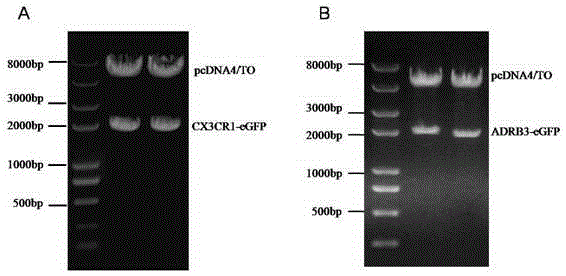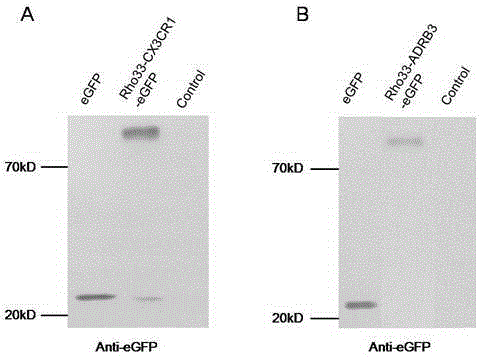Fusion gene building method for effectively screening GPCR (G Protein-Coupled Receptor) expression
A technology of coupled receptors and fusion genes, applied in the fields of molecular imaging and cell biology, can solve the problems of inconvenient protein research, high cost, and experimental failure, and achieve the effect of increasing protein expression, increasing ratio, and increasing yield
- Summary
- Abstract
- Description
- Claims
- Application Information
AI Technical Summary
Problems solved by technology
Method used
Image
Examples
Embodiment 1
[0048] The fusion gene Rho33-protease-CX3CR1-1D4-protease-eGFP was constructed by overlapping extension PCR method and expressed in HEK293 cells. The steps are as follows:
[0049] 1) Using the existing pCDNA4 / TO-rhodopsin plasmid in the laboratory as a template, use the pcDNA4 / TO plasmid general upstream primer CMV and the synthetic downstream primer Rho(33aa)1 to amplify fragment 1, whose size is about 300bp. The primers used are as follows:
[0050] CMV: 5'-CGCAAATGGGCGGTAGGCGTG-3'
[0051] Rho(33aa) 1:5'- GGGGTTCTCTCAT CTCAGCCAGGTAG-3' ("_" means CX3CR1 fragment)
[0052] 2) Using the existing pcDNA4 / TO-CX3CR1 plasmid in the laboratory as a template, the synthetic upstream primers Rho(33aa)2 and eGFP1 were used to amplify fragment 2 with a size of about 1100bp. The primers used are as follows:
[0053] Rho(33aa)2: 5'-CTACCTGGCTGAG ATGAGAGAACCCC -3' ("_" indicates CX3CR1 fragment)
[0054] eGFP1: 5'- CTTGCTCACCAT GAGAAGGAGC-3' ("_" indicates eGFP fragment)
[005...
Embodiment 2
[0084] The fusion gene Rho33-protease-ADRB3-1D4-protease-eGFP was constructed by one-step gene cloning and expressed in HEK293 cells. The steps are as follows:
[0085] 1) Using the existing pCDNA4 / TO-rhodopsin plasmid in the laboratory as a template, the synthetic upstream primer FP and downstream primer Rho(33aa) 1' were used to amplify fragment 1 with a size of about 150 bp. The primers used are as follows:
[0086] FP: 5'-CTAGCGTTTAAACTTAAGCTT ATGAATGGCACAG -3, ("_" indicates a Rhodopsin fragment)
[0087] Rho(33aa) 1':5'- CCACGGAGCCAT CTCAGCCAGGTAG-3' ("_" indicates ADRB3 fragment)
[0088] 2) Using the existing pcDNA4 / TO-ADRB3 plasmid in the laboratory as a template, the synthetic upstream primer Rho(33aa) 2' and downstream primer RP were used to amplify fragment 2 with a size of about 1200bp. The primers used are as follows:
[0089] Rho(33aa) 2':5'-CTACCTGGCTGAG ATGGCTCCGTGG -3' ("_" indicates ADRB3 fragment)
[0090] RP: 5'- CTTGCTCACCAT AGAAACTCCCAAG-3' (...
PUM
 Login to View More
Login to View More Abstract
Description
Claims
Application Information
 Login to View More
Login to View More - R&D Engineer
- R&D Manager
- IP Professional
- Industry Leading Data Capabilities
- Powerful AI technology
- Patent DNA Extraction
Browse by: Latest US Patents, China's latest patents, Technical Efficacy Thesaurus, Application Domain, Technology Topic, Popular Technical Reports.
© 2024 PatSnap. All rights reserved.Legal|Privacy policy|Modern Slavery Act Transparency Statement|Sitemap|About US| Contact US: help@patsnap.com










